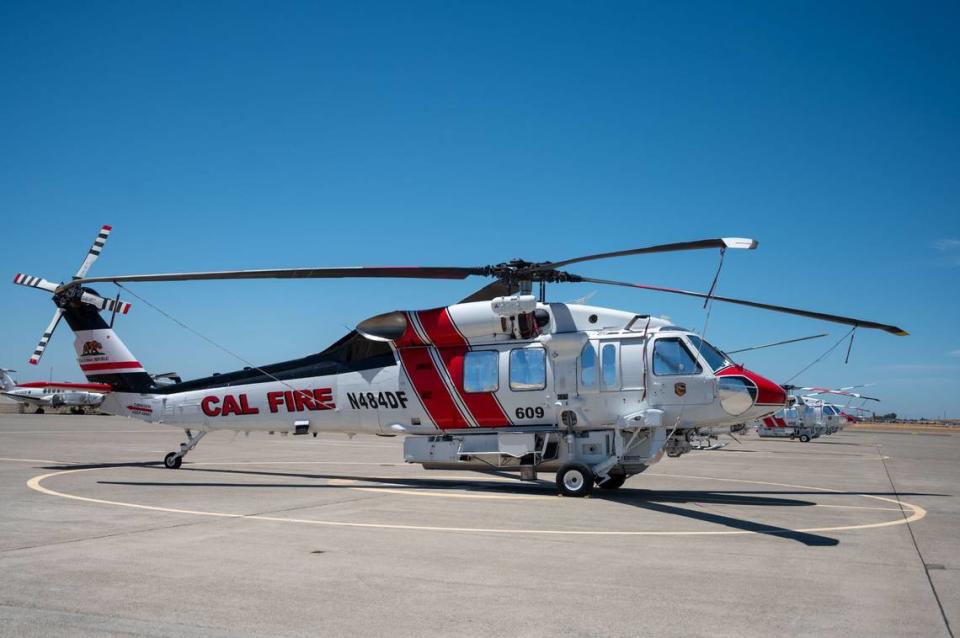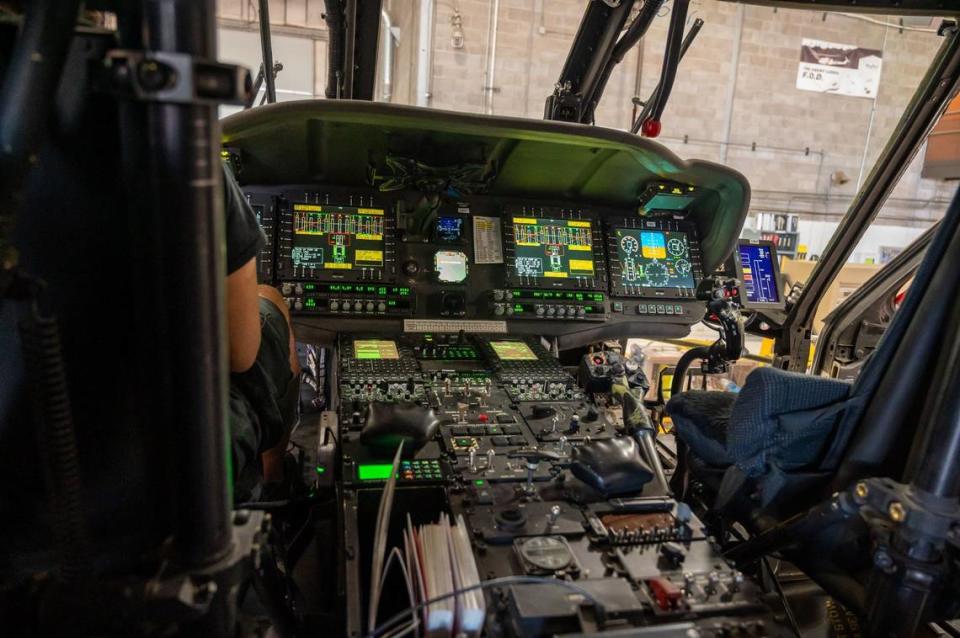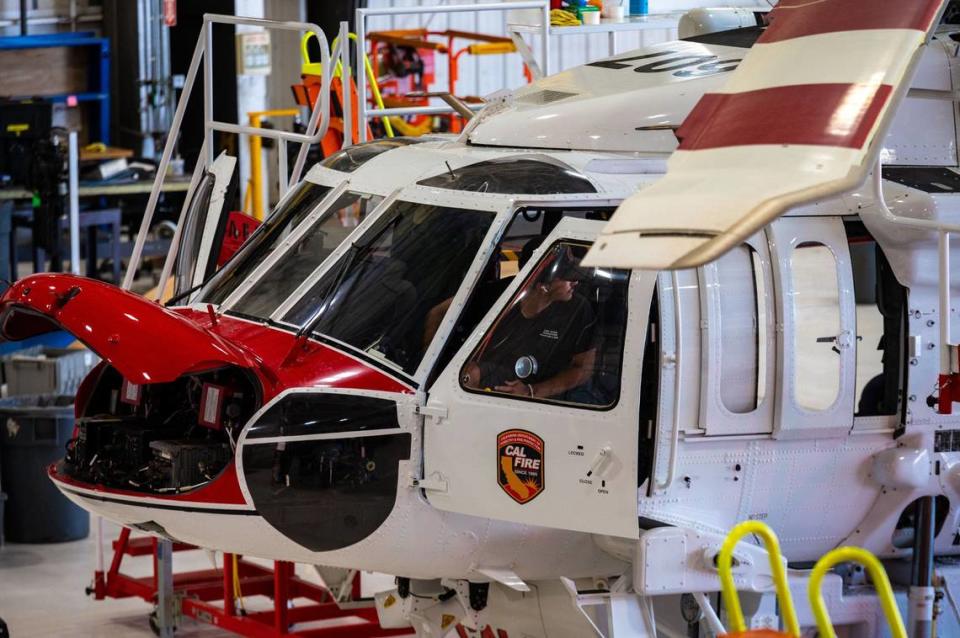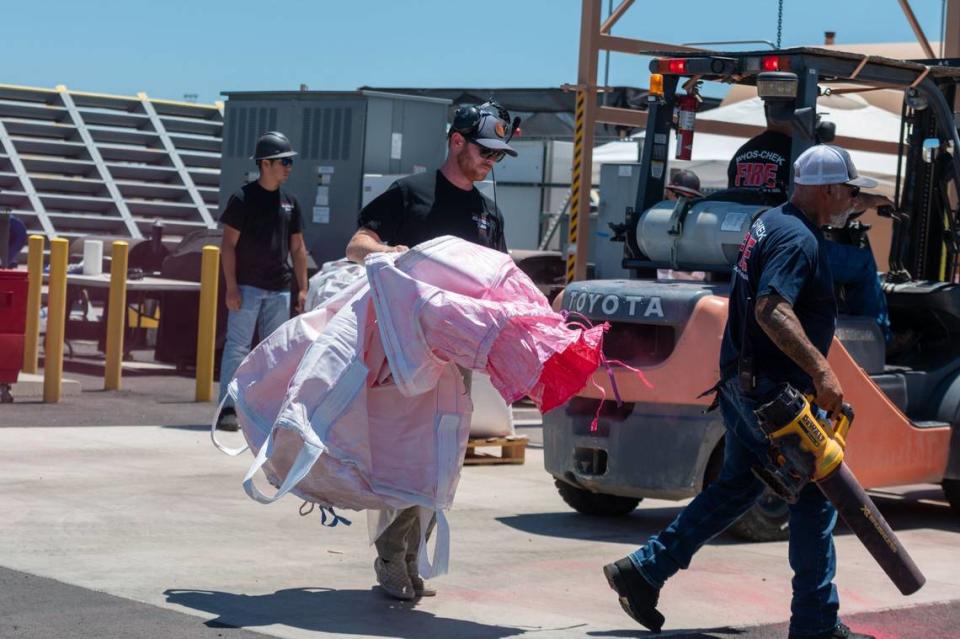Night vision, new helicopters are pushing the frontiers of fighting wildfires in California
The California Department of Forestry and Fire Protection boasts the largest civil firefighting aviation unit in the world and, as fires become more destructive and frequent, it’s only getting bigger.
With more than 60 helicopters and fixed-wing aircraft used in tandem to monitor and attack fires, Cal Fire has been able to extinguish thousands of wildfires every year. But recent fire seasons have shattered records for the largest, deadliest and most destructive fires in California, and 2024’s fire season is already more active than the year-to-date average of the last five years.
To meet the state’s need for firefighting operations, the agency has been bringing in new members to its aviation units who are keeping Cal Fire on the edge of faster responses.
Cal Fire’s newest addition to its helicopter fleet is the Fire Hawk — a Sikorsky S70i Black Hawk retrofitted to drop water or fire retardant, as well as conduct hoist rescue and night operations.
Cal Fire received funding in 2018 to purchase 12 Fire Hawks to build the new fleet, later securing funds for an additional four copters from the Department of Defense in 2022. Cal Fire currently has 14 Fire Hawks in its fleet, with the other two arriving in 2025.
The newest helicopters are a heavy-duty complement to Cal Fire’s fleet of 34-year-old UH-1H Super Huey helicopters, also military surplus. The Fire Hawks are able to dump more than two-and-a-half times the amount of foam or water that the Super Hueys can, making them a good choice for responding to fires quickly.
Both models of helicopters are an initial attack resource, meaning they head to fires as soon as one is reported to deliver ground crews quicker than a truck could then load up with water or fire retardant to drop on the blaze.
Initial attack operations like this can help stop fires early on or avoid significant destruction to densely populated areas from larger fires, like the Park Fire that broke out Wednesday afternoon.
The blaze, which reached 71,000 acres by noon Thursday, had at least one Fire Hawk aiding in the fire suppression or rescue operations in the area around 1 p.m. Thursday.
Mike Schanley, a contract forestry fire pilot at Cal Fire’s Boggs Mountain helitack base, said the introduction of the Fire Hawks and their huge water tanks have been a game changer for aerial firefighting operations.
“(With the Huey), you hit the button once and ... that water is coming out all at once and there’s no way around it,” Schanley said. “(With the Fire Hawk), I control the drop, I can do multiple drops ... it’s like adding multiple tools in the same aircraft.”
He said he can adjust the water drop to what works best for a specific fire situation. For example, in a wide grass fire, he uses the most conservative drop level to shower water across a quarter-mile or more in a straight line, but for tall trees, he can open the tank wide to create a dense waterfall.
The introduction of Fire Hawks brought another major innovation to Cal Fire’s operations: The ability to fight fires at night.

Firefighting after dark
With climate change making firefighting conditions more intense during the day, hand crews often work into the night to stop fire progression and get it under control as conditions moderate. With the help of aviation units, transporting crews and dropping water or foam overnight is made even simpler.
As its predecessor, the Black Hawk, is designed for day and night military use, the Fire Hawk comes standard with low cockpit lighting, rendering it capable of flying and attacking fires after the sun has gone down.
The dimmed cockpit lights allow pilots to see at night with specialized night-vision goggles, similar to those used by the military in low-light operations. The goggles aid in pitch-black situations by amplifying infrared and visible spectrum light waves to see active flames and hot spots around wildfire areas, according to Daniel Anderson, a Cal Fire pilot and flight instructor.
Although Cal Fire’s Super Hueys could be retrofitted with dimmer lights or a “nighttime mode,” Schanley said he likes that the Fire Hawks’ technology already accommodates the goggles.
“We purchased the aircraft configured, ready to go for night vision even though at the time ... we were still just flying (during the) day,” he said. “We thought ahead, which I’m very grateful for.”

Training for night drops
According to Anderson, eight out of the 10 Cal Fire bases that operate Fire Hawks have received training to fly operations at night.
While the newer helicopters have opened up the possibility for 24/7 fire fighting, it is not typically practiced, Anderson said. To avoid crew exhaustion, firefighting efforts often end about 2 a.m.
Only certain aerial bases are allowed to fly 24 hours, according to Schanley, as they would require more pilots than normal. Boggs Mountain is still too small, but Schanley said he’s confident it will be able to expand and reach 24-hour capability.
Training to fly a helicopter for Cal Fire is a multi-step process that took Schanley more than a year, and it starts at the Aviation Management Unit, based out of McClellan Airport near North Highlands.

McClellan’s operations have programs to train new pilots and introduce new training for existing pilots, including nighttime flying. The programs include lecture-style classroom sessions with chief pilots teaching about the various aspects of the piloting job, as well as interactive lessons to get practical training before going up in aircraft.
One of the interactive methods pilots are trained in is through aircraft-specific simulators that place the pilots in a replicated mission scenario with a large curved screen. The AMU operates a Fire Hawk simulator which pilots say is highly realistic and replicates the helicopter exactly.
Shane Roberson, a recently hired Fire Hawk pilot, said having a simulated version of the Fire Hawk to safely practice flying is highly beneficial.
“As far as the cockpit layout, it’s identical, which is a huge tool,” Roberson said. “The best part about the sim is that you can pause it. So when we flip a switch wrong, we can ... walk through all the different emergency procedures and get to know the aircraft.”
Once they clear practical training and get up in a real Fire Hawk, Cal Fire pilots typically must fly the helicopter during the daytime for about a year before being eligible to receive nighttime training. This helps ensure they are already comfortable in the helicopter before adding on the additional challenges of low light and night vision goggles, Anderson said.
“We don’t want to rush them in,” Anderson said. “Just one accident could slow or shut the whole program down.”
Schanley has been flying the Fire Hawk since 2020 and has accumulated thousands of daytime flight hours, including countless hours of daytime and nighttime flight over decades of flying other helicopters.
Before coming to work at Cal Fire, first as a contract worker and later full-time, he flew as a certified flight instructor, a military contract pilot, a news helicopter pilot and more. He flew checks from Los Angeles bank branches to a central processing location on weeknights, operated aircraft for helicopter companies in Idaho, off the Gulf of Mexico and in the Arctic, and aerially fought fires for the U.S. Forest Service.
“This (job) takes me all the way back to when I was 12 years old and I’d see the LA County Fire Department (aerial units),” Schanley said. “I’m doing the job that I’ve always wanted to do since I was a kid.”
Still, Schanley only recently finished his 25 hours of flight training that certifies him for nighttime aerial fire fighting, which included practicing water drops — though not over fires — and how to scan an area with the night vision goggles.
“I’m still dipping my toe into this ... but I’m pretty excited about the night thing,” Schanley said. “I’m definitely all in on this project.”


